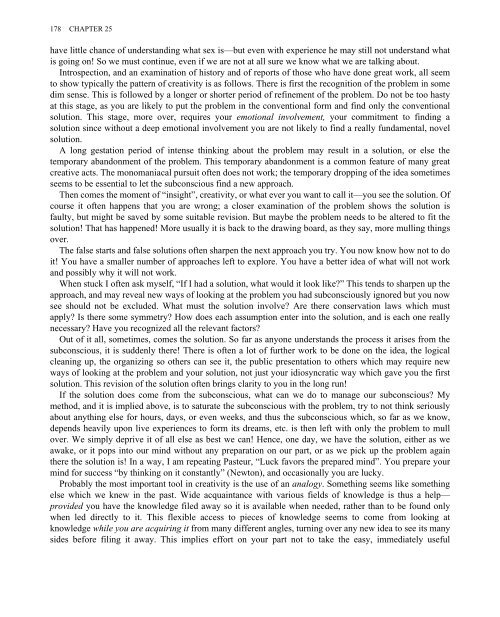hamming
hamming
hamming
You also want an ePaper? Increase the reach of your titles
YUMPU automatically turns print PDFs into web optimized ePapers that Google loves.
178 CHAPTER 25have little chance of understanding what sex is—but even with experience he may still not understand whatis going on! So we must continue, even if we are not at all sure we know what we are talking about.Introspection, and an examination of history and of reports of those who have done great work, all seemto show typically the pattern of creativity is as follows. There is first the recognition of the problem in somedim sense. This is followed by a longer or shorter period of refinement of the problem. Do not be too hastyat this stage, as you are likely to put the problem in the conventional form and find only the conventionalsolution. This stage, more over, requires your emotional involvement, your commitment to finding asolution since without a deep emotional involvement you are not likely to find a really fundamental, novelsolution.A long gestation period of intense thinking about the problem may result in a solution, or else thetemporary abandonment of the problem. This temporary abandonment is a common feature of many greatcreative acts. The monomaniacal pursuit often does not work; the temporary dropping of the idea sometimesseems to be essential to let the subconscious find a new approach.Then comes the moment of “insight”, creativity, or what ever you want to call it—you see the solution. Ofcourse it often happens that you are wrong; a closer examination of the problem shows the solution isfaulty, but might be saved by some suitable revision. But maybe the problem needs to be altered to fit thesolution! That has happened! More usually it is back to the drawing board, as they say, more mulling thingsover.The false starts and false solutions often sharpen the next approach you try. You now know how not to doit! You have a smaller number of approaches left to explore. You have a better idea of what will not workand possibly why it will not work.When stuck I often ask myself, “If I had a solution, what would it look like?” This tends to sharpen up theapproach, and may reveal new ways of looking at the problem you had subconsciously ignored but you nowsee should not be excluded. What must the solution involve? Are there conservation laws which mustapply? Is there some symmetry? How does each assumption enter into the solution, and is each one reallynecessary? Have you recognized all the relevant factors?Out of it all, sometimes, comes the solution. So far as anyone understands the process it arises from thesubconscious, it is suddenly there! There is often a lot of further work to be done on the idea, the logicalcleaning up, the organizing so others can see it, the public presentation to others which may require newways of looking at the problem and your solution, not just your idiosyncratic way which gave you the firstsolution. This revision of the solution often brings clarity to you in the long run!If the solution does come from the subconscious, what can we do to manage our subconscious? Mymethod, and it is implied above, is to saturate the subconscious with the problem, try to not think seriouslyabout anything else for hours, days, or even weeks, and thus the subconscious which, so far as we know,depends heavily upon live experiences to form its dreams, etc. is then left with only the problem to mullover. We simply deprive it of all else as best we can! Hence, one day, we have the solution, either as weawake, or it pops into our mind without any preparation on our part, or as we pick up the problem againthere the solution is! In a way, I am repeating Pasteur, “Luck favors the prepared mind”. You prepare yourmind for success “by thinking on it constantly” (Newton), and occasionally you are lucky.Probably the most important tool in creativity is the use of an analogy. Something seems like somethingelse which we knew in the past. Wide acquaintance with various fields of knowledge is thus a help—provided you have the knowledge filed away so it is available when needed, rather than to be found onlywhen led directly to it. This flexible access to pieces of knowledge seems to come from looking atknowledge while you are acquiring it from many different angles, turning over any new idea to see its manysides before filing it away. This implies effort on your part not to take the easy, immediately useful


